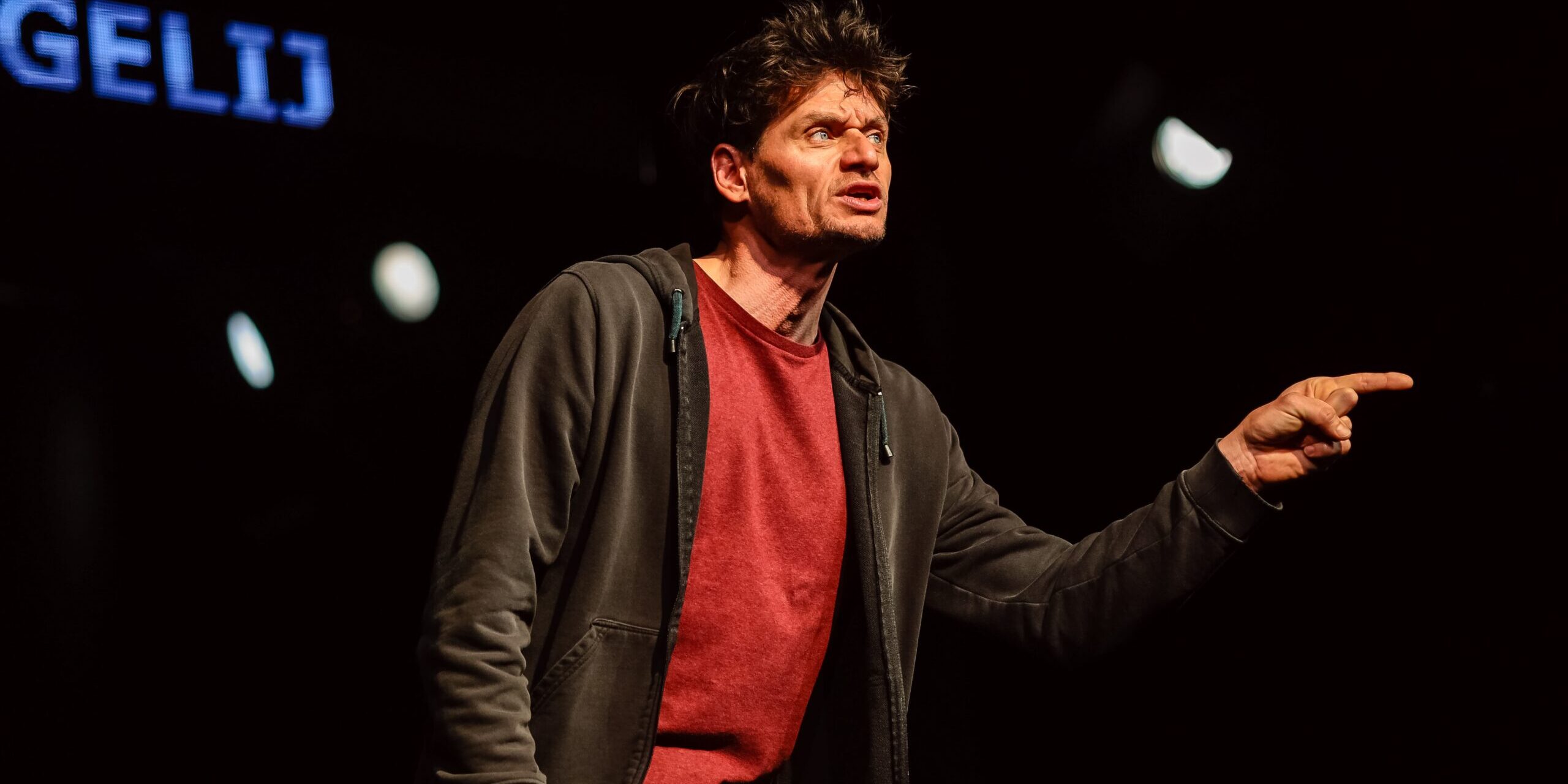Mladinsko Theatre, premiere 23rd May 2023
In history of theatre, there have been many different attempts to eliminate the sense of fiction. Naturalism, for example, aimed to create an illusion of reality by focusing on everyday life and filling the stage with detailed scenography. At the other end of the spectrum, artists such as Jerzy Grotowski tried to eliminate the division between actors and spectators in order to create a collective performance. All this just to make the experience feel real.
In the The Last Fiction Piece, director Boris Nikitin goes a step further and plays with the conventions of fiction and truth in theatre on another level. The production touches on the issue of faith in reality as well as faith at every level: in oneself, in God and love.
The structure of the show sees an actor’s monologues interrupted by gospel songs which are performed by a youth choir. The actor’s performance oscillates between the format of a church sermon given by a charismatic pastor, a motivational speech and a TedTalk. At first, one gets the impression that what is happening on stage is auto-theatre: a performance in which an actor decides to share experiences, emotions, events that happened to him in the form of a lecture. However, between the lines, a philosophical reflection on faith and truth is occurring.
The title of the play may evoke associations with Leonardo da Vinci’s ‘The Last Supper’. This, combined with the sermon format, prompts us to follow an interpretive path that leads us to decipher the show in terms of the Christian faith. Over the course of the nearly hour-and-a-half-long performance, the production features many symbols of Christianity.
On stage, there is only a piano and chairs for the chorus; the performance begins with a voice warm-up for the chorus, who then sit down. The only exception is a man who reveals himself as the main actor of the performance – Primož Bezjak. He informs the audience that he will be playing the role of the originator of the project, and mentions that the show was originally supposed to be staged inside a Christian church, but no church would allow this.
The first scene is a story about faith that ties the whole play together. Bezjak recites the Gospel of St. John, in which the Thomas the Doubter is mentioned. The scene, which will be familiar to many, where Thomas puts his finger in Jesus’ wounds to see if the Christ is really resurrected, is not in the text. All that was written is: “Reach hither thy finger, and behold my hands; and reach hither thy hand, and thrust it into my side: and be not faithless, but believing” and immediately after, there’s Thomas’ response: “My Lord and my God!“. This could mean that Thomas believed right then and did not feel the need to check the wounds. But most painters have interpreted it the other way round: the blank space – to them and almost everyone else – is a moment when Thomas reaches out and touches the Christ. It is this gospel fragment that is the main driver for the performance’s further plot development and reflection on fiction and faith.
The first interpretive layer of the play is the theme of faith. It is impossible to avoid direct associations with the Church. The leader preaching to us and the characteristic choir automatically direct our attention to the Christian faith. In one of the scenes the actor recalls the story of his prayer to God, begging him for help. That causes us in the audience to rethink our own approach to faith. We ask ourselves whether we are able to be like St. Thomas, who – according to the show’s interpretation – stopped questioning and started believing.
During the performance, the effect of being part of the mass is heightened by the speaker, who preaches and tells people to return to primordial love as a universal idea that will make life better. However, during that speech about love, the preacher begins to look more like a hippie sect leader urging people to follow the ideas of the 1960s. Another direct reference to the Christian church is the procedure of exchanging the peace by turning to your neighbour, shaking their hand and saying: peace be with you. Bezjak urges the audience to change this gesture into the exchange of declarations of love. After an unsuccessful attempt to persuade people to do this, the actor starts telling the audience that he loves them, walking around the room and approaching them one by one. The last scene is a performance of a Britney Spears song Baby One More Time the lyrics of which are “My loneliness is killing me (and I), I must confess I still believe (still believe), When I’m not with you I lose my mind, Give me a sign… “. The words of the pop song, which – according to Nikitin – could also have been said by St. Thomas, end the entire show.
Morals about love and faith are supported by private, or so it would seem, stories about struggles with depression, alcoholism and love life. They are meant to help the viewers to find the right path in life, to find a way to free themselves from the expectations of society. The actor preaches about how one should live based on his own experiences, which provokes a response: “don’t tell me how to live.” Could this be meant as another criticism of the Church, which continues to tell us what decisions we should make? Or do the show’s creators really want to give us good advice? As we go through the stories with the actor, it begins to feel more like a private therapy session of the main character, less like a church service. All of this would be even more irritating if it were true. However, the second layer of interpretation tells us that the theatre audience is participating in a meta performance that imitates reality, because, after all, we are in a theatre, there is no mass, the performer is just performing his role and acting, and the text is not a sermon but a previously written play.
In an interview the Italian theatre director Romeo Castelluci said: “A work of fiction is perhaps a form of super reality.” Nikitin, through many layers of fiction, has built in the play The Last Fiction Piece as a form of super reality. The final moral about love and faith may seem to be the ultimate lesson learned from the play. However, knowing that the story of Thomas also includes a reflection on what is true and what is not, and furthermore knowing the director’s interests, and his tendency to play with form between documentary theatre, performance, and illusion theatre, one must wonder what is true of the words heard from the stage? The play imitating reality, presented as participation in a collective performance, gives the illusion of being part of an experimental theatre. Meanwhile, the audience witnesses what usually happens in the theatre – a fictional story.
In the end, of all the interpretive paths dealing with the themes of truth, faith and love, only chaos and confusion remain. Double layer of fiction has caused the meaning to disappear. If the main purpose of the play was to show that theatre is fiction (which is one of the main ideas of the theatre), was reflection on religion and love even necessary? The meaning of the show is unclear and could lead to the conclusion that everything is fiction along with theatre, faith and love. By claiming during the performer’s motivational speech that these should be the pillars of a well-functioning human being, it gets to the point where everything that has been said somehow excludes itself. Such a dichotomy makes me wonder if this is even the right track in theatre.
Credits:
Author/director: Boris Nikitin//Translation: Jan Krmelj//Dramaturgy: Goran Injac//Choice of costumes: Goran Injac, Boris Nikitin
Cast: Primož Bezjak, the Tone Tomšič Academic Choir
For more information, visit: Mladinsko.com
Further reading: an interview with Goran Injac, artistic director of the Mladinsko Theatre: “I’m always looking for a way to initiate a public debate”
Karolina Bugajak is a theater critic from Poland, currently living in Ljubljana. She studied culture and contemporary art at the University of Lodz. The title of her master's thesis was "Theatricality and Exaggeration. Camp aesthetics as a strategy for creating new identities in the plays of Grzegorz Jaremko". Her main theatrical interests include topics such as institutional criticism, the representation of marginalized groups in plays, and most recently the theater of the former Yugoslav states.








